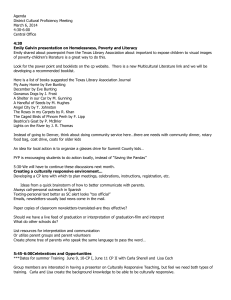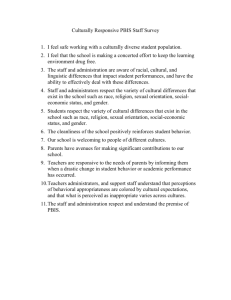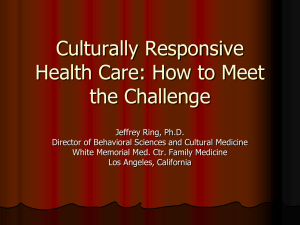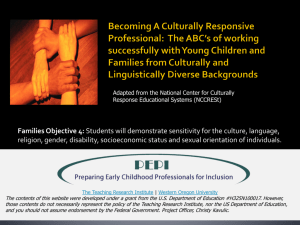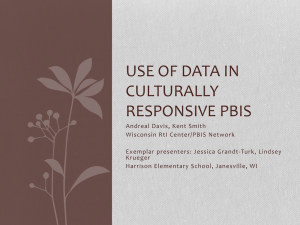Language, Literacy, and Learning in Mexican American SEL's
advertisement
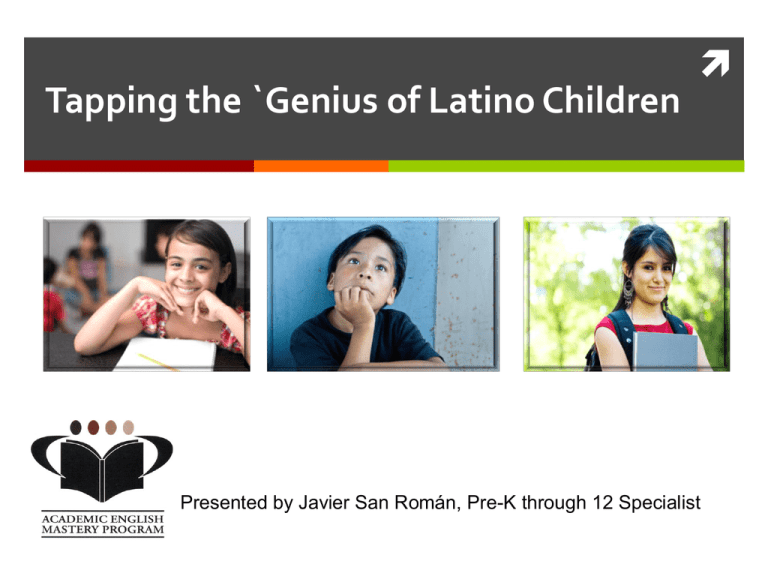
Tapping the `Genius of Latino Children Presented by Javier San Román, Pre-K through 12 Specialist Educación Why do you work at things that you are never going to see completed? Better to work in the fields, which will give you a crop in months, and not in the planting of trees that will be large when you have already died." "You are a fool or crazy, because you work for nothing.” The crazy man defended himself and said: "Yes, it is true, I am not going to see these trees full grown, full of branches, leaves and birds, nor will my eyes see children playing under their shade. But, if all of us work just for the present and for just the following day: who will plant the trees that our descendents are going to need, in order to have shelter, comfort, and joy?" Source: Mayan oral tradition Tools of Genius Do you sometime have days when everything flows with you and you just can't seem to say or do anything wrong? This was the power of my two grandmothers, Doña Guadalupe and Doña Margarita. This is also what my dad began teaching me on the night he passed over to the spirit world. No matter what catastrophe came his way, his life always seemed blessed and full of magic. -VictorVillaseñor, acclaimed Mexican American author California Population,1990-2050 60 Percent of Total Population 57 56 54 53 50 54 51.5 50 47 40 47 39 43 White 34 33 30 26 27 28 29 Latino 30 29 26 Af Am 23 20 10 0 Asian 9 10 10 11 11 7 7 7 7 7 11 7 12 13 13 13 12 7 7 7 7 1.9 2 2 2 2 6 2 1990 1992 1994 1996 1998 2000 2010 2020 2030 2040 2050 Source: Population Projections, Department of Finance, State of California, 2004 Multirace Public Education and the Latino Experience The Fight Against Segregation in the 30’s, 40’s, & 50’s -ACCESS Struggle for Justice and Fairness in Education in the 60’s, 70’s, 80’s, 90’s, 00’s, and 10’s -EQUITY School Funding & Race To The Top in the 10’s- ADEQUACY Subtractive Schooling DeVillar (1994) argues that U.S.-born, Latino “minority” youth are seen by schools and society as lacking the linguistic, cultural, moral, and intellectual traits the assimilationist curriculum demands. These students are perceived as requiring ever more cultural assimilation and resocialization-as if the potency of the initial treatments somehow systematically fades. Access, Equity, and Adequacy in Gifted Education Statistics show that African Americans, Hispanics, and Native Americans are underrepresented by some 50 to 70% (Elementary and Secondary Schools Civil Rights Survey, 2002; U.S. Department of Education, 1993). According to the Office for Civil Rights, a discrepancy of 20% or more is unacceptable and may indicate biases in instruments, policies, procedures, and practices (Ford & Frazier Trotman, 2001) [No culture or group has a monopoly on giftedness. Disparities undermine the validity of giftedness and throw into doubt whether we are talking about privilege or ability.] Source: Elementary and Secondary Schools Civil Rights Survey, 2002 Think-Pair-Share Why do these disparities exist in the identification of Latino students? What are some ways that we can or are rectifying this situation? Pillars of CRRE for Mexican American/Latino Students Culturally Relevant and Responsive Education for Mexican American/Latino Students Educación Flor y Canto Educación Although educación has implications for pedagogy, it is first a foundational cultural construct that provides instructions on how one should live in the world. With its emphasis on respect, responsibility, and sociality, it provides a benchmark against which all humans are to be judged, formally educated or not. Dr. Angela Valenzuela-Subtractive Schooling: US Mexican Youth and the Politics of Caring In Xochitl In Cuicatl (Flor y Canto) Culture and Cognition Schools of Thought Linguistic relativity-early 20th century (Sapir Wharf Hypothesis) Universalism-mid-20th century Piaget & Vygotsky Cognitive/Learning Styles-70’s-90’s (field dependent vs field sensitive/dependent Repertoires of Practice-Gutierrez & Rogoff (present) Seminal Work on Culture to Cognition (Ramirez & Castañeda, 1974) Validation and Negation Field Independent Style-Is validated by traditional public education Field Sensitive/Dependent-is typically negated by traditional public education Perceive Sequentially Perceive globally Experience information in a segmented fashion Experience information holistically Make broad general distinctions between concepts See relationships Learn material best with social content Impose structure or restrictions on information Learn social material only as an intentional task Develop interest in concepts for their own sake Attend best to material relevant to their own experience Provide for self-structure Require an organizational framework Ignore or pay little attention to criticism Internalize criticism (Dembo, 1988) Looking at Cultural Factors as Repertoires of Practice We must move beyond the assumption that cultural communities are static and that general traits of individuals are attributable categorically to ethnicgroup membership (Gutierrez & Rogoff, 2003). Individuals’ and groups’ experience in activities not their traits-become the focus of a cultural analysis. These socially and culturally organized proclivities are referred to as Repertoires of Practice (ROP’s). Identifying ROP’s As teachers we must focus our analyses on what takes hold as youth move within and across tasks, contexts, and spatial, linguistic, and sociocultural borders. This allows us to attend to successful pathways and contextual supports that promote youth’s literacy and learning. Observed regularities in students’ practices could then be attributed to their history of participation in familiar cultural activities (repertoires of practice). California Department of Education PD & Curriculum Support Division Core Components-RtI A Cohesive RtI process integrates resources from general education, categorical programs and special education into a comprehensive system of core instruction and interventions to benefit every student. The following core components are critical to the full implementation 1. High-quality classroom instruction. Students receive high-quality culturally relevant, standards-based instruction in their classroom setting by highly qualified teachers. 2. Research-based instruction. The instruction that is provided within the classroom is culturally responsive and has been demonstrated to be effective through scientific research. Source: PD & Curriculum Support Division, CDE: 916-323-6440 Differentiated Instruction Differentiated Instruction is an instructional concept that maximizes learning for ALL students—regardless of skill level or background Differentiation modifies: content, process, and product When a teacher differentiates instruction, he or she uses the best teaching practices and strategies to create different pathways that respond to the needs of diverse learners. Tomlinson, 2003 Learning Cycle in and Decision Factors in Differentiated Instruction Culturally Responsive Teaching Culturally Relevant and Responsive Education (CRRE) is defined as adjusting how we teach to the needs and experiences of students by using their cultural knowledge, prior experiences, frames of reference, and performance styles to make learning encounters more relevant and effective for them. The research [continuously] affirms that culture, teaching, and learning are interconnected and that school achievement increases to the extent that teaching employs the cultural referents of the students to whom it is directed (Gay, 2000). Geneva Gay Learning Cycle in and Decision Factors in Differentiated Culturally Relevant & Responsive Education Instruction Curriculum: Reshaping the curriculum to make it relevant Student: Repertoires of Practice & Funds of Knowledge (Difference not Deficit!) Content: Planning considers students’ funds of knowledge for relevancy Process: -Plans for ROPs -Culturally Responsive Assessment of Content: Provides for a variety of ways to demonstrate mastery Summative Evaluation: Is now equitable Cultural Giftedness Cultural Giftedness-being exceptional in cultural arts, music, historic ,cultural knowledge/ traditions, storytelling, genealogy, and language. Includes ability in culturally valued qualities: bravery, hospitality, spirituality, industriousness, familism, etc… If cultural expertise is not treated equitably, what message does this give students from these cultures? Think of gifted learners from ethnic groups that you work with. Do they have culturally valued qualities that are important components of their concept of giftedness? Bevan-Brown, 2005 Culturally Responsive Teaching Does what traditional instructional ideologies and actions do for middle-class European Americans. That is, it filters curriculum content and teaching strategies through their cultural frames of reference to make the content more personally meaningful and easier to master. Geneva Gay References Banks & Banks (2010). Multicultural Education: Issues and Perspectives. New Jersey: Wiley & Sons. Bevan-Brown (2005). Providing a Culturally Responsive Environment for Gifted Maori Learners. International Education Journal, 2005 6(2) 150-155. Fraga, R. (2008) Latinos and Education in the 21st Century: Accepting the Responsibilities of Leadership. Presentation at CA Latino School Boards Association, October 10, 2008. Gay, G.(2000). Culturally Responsive Teaching: Theory Research And Practice. New York: Teachers College Press. Hollie, S. (2012). Culturally and Linguistically Responsive Teaching and Learning: Classroom Practices for Student Success. CA : Shell Education Ramírez & Castañeda (1974). Cultural Democracy, Bicognitive Development, and Education. San Diego: Academic Press. Santamaria, L. (2009). Culturally Responsive Differentiated Instruction: Narrowing Gaps between Best Pedagogical Practices Benefiting All Learners. Retrieved from Teachers College Record, v111 n1 p214-247. Tomlinson, L. (1999). The Differentiated Classroom: Responding to the Needs of All Learners. Virginia:ASCD.
